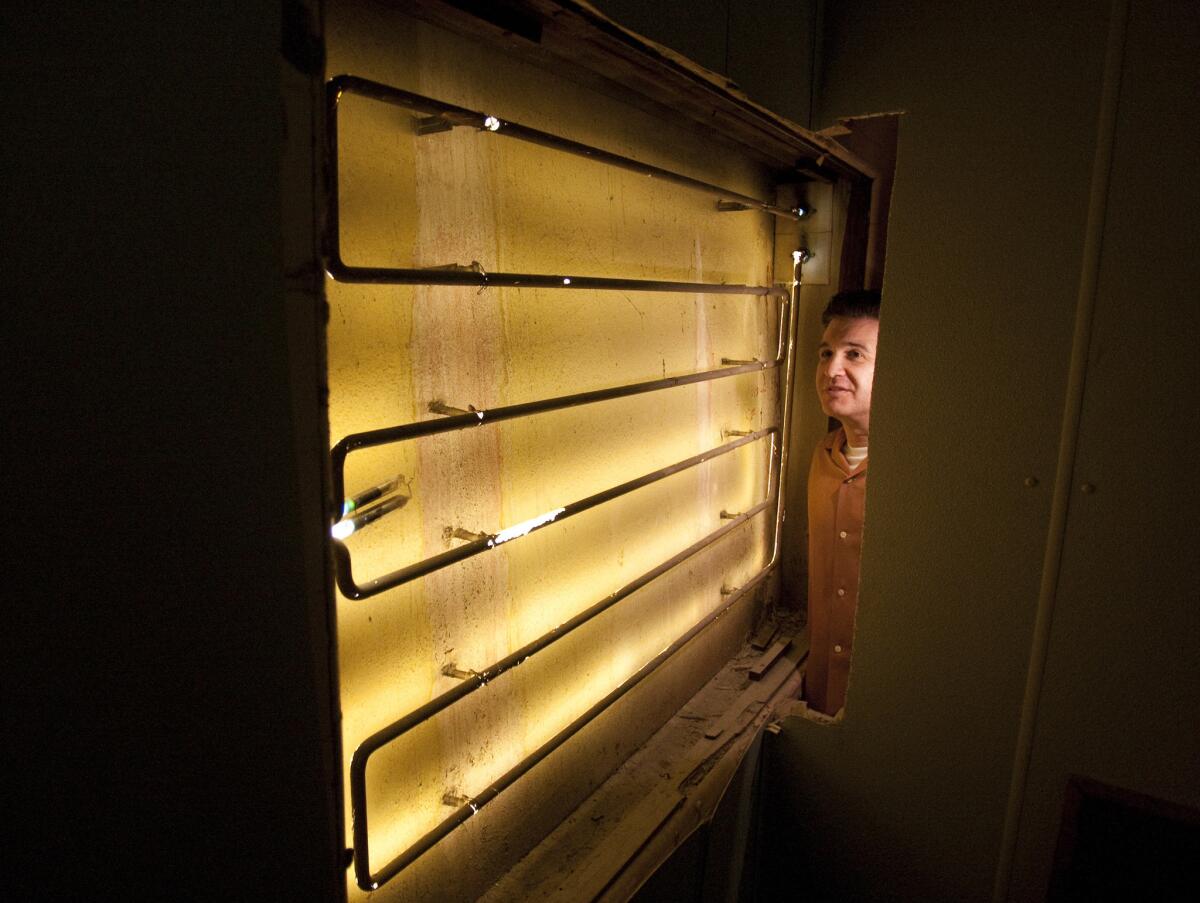From the archives:: A landmarkâs light fantastic: Neon lamp glows for no one for decades at Cliftonâs

Andrew Meieran, the new owner of Cliftonâs Cafeteria, examines a neon light that was glowing behind a wall for about 60 years.
Theyâre not kidding when they say theyâll leave the light on for you.
A long-forgotten neon lamp that was switched on during the Great Depression and left burning for about 77 years has been discovered hidden behind a dusty partition at Cliftonâs Cafeteria.
The find was made amid an extensive renovation of the downtown eatery, according to the buildingâs owner, Andrew Meieran.
The neon fixture is believed to have been installed in 1935 when Clifford Clinton purchased the lease to Boos Bros. Cafeteria on Broadway and 7th Street and converted the place into a forest-themed restaurant.
The discovery has delighted fans of neon lighting, who point out that Americaâs first neon sign was erected blocks away at Olympic Boulevard and Hope Street. Thatâs where automobile dealer Earle C. Anthony installed a glowing âPackardâ emblem outside his showroom in 1923.
------------
For The Record
May 31, 2012: An article in the May 26 LATExtra section about the discovery of a hidden neon lighting fixture at Cliftonâs Cafeteria misquoted Los Angeles Conservancy Director Linda Dishman as saying, âThe Cliftons saved everything.â In fact, she said, âThe Clintons saved everything,â speaking of the longtime owners of the restaurant.
------------
âNeon lamps can last 20 to 40 years before the glass deteriorates or transformers go out,â said Kim Koga, executive director of the Museum of Neon Art. âThat this one has survived, lit, for as long as it has is incredible.â
The newly revealed lamp isnât exactly a work of art, however.
The walls of the restaurant featured numerous hand-tinted transparencies of mountain and forest landscapes, each of which was backlit by a rectangular neon light.
One such light was installed in a window-like nook in a basement restroom, where it softly illuminated a woodland scene.
In 1949, the nook was covered over with plastic and plywood when part of the restroom was partitioned off as a storage area.
But for some reason, workmen never got around to disconnecting the electricity. For the next 62 years the illuminated tubing was hidden within the wall. Meieran estimates that the neon tube has racked up more than $17,000 in electrical bills.
The glowing light was discovered Feb. 9 when Meieran inspected the small storeroom with a member of his renovation crew.
âWe were using flashlights, and I thought I caught a glimpse of a little light coming through the wall,â Meieran said. âI asked, âWhat is that?ââ
The pair shut off their flashlights, thinking the beams were reflecting off something in the wall. A faint light still glowed within the pitch blackness of the storeroom.
Wondering whether the light might be coming from the basement next door, Meieran peeled away more of the wall covering. When the hole was large enough to stick his phone camera through, he reached inside and snapped several pictures, including one that clearly showed electrodes at the base of neon tubing.
Puzzled, Meieran uncovered the entire 3-by-5-foot nook, exposing six rows of neon tubing. Blackout paint covered one half of the neon tubes to obscure them.
Koga said she was amazed that insects or rodents werenât drawn to the warmth of the fragile neon tubes, jeopardizing their operation.
She speculated that being out of the weather and away from human touch for so long has contributed to the lightâs longevity.
Meieran bought the building from the Clinton family for $3.6 million and plans to spend an additional $3.5 million on renovations before reopening it next year.
He said workers have found other treasures within its walls and hidden crannies.
The building was constructed in 1904 as a furniture store, and renovation workers have uncovered a steel support post that was painted with directions to various store departments, as well as a non-functioning âice waterâ neon sign from the 1930s.
Workers have also unearthed vestiges of past renovations. A piece of Sheetrock used in a 1949 remodeling bears the autographs of workers.
Other items recovered by workers include Edison incandescent light bulbs circa 1932, original Boos Bros. Cafeteria tableware, an ancient Orpheum playbill and long-hidden original subway wall tiles and decorative honeycomb floor tiles in the cafeteriaâs serving line area.
âYouâre literally peeling away layers of time here,â said Rick Ringer, a partner in the Cliftonâs renovation project who likened the work to an archaeological dig.
Clifford Clintonâs original 1931-32 diary also turned up, Meieran said. In it, he outlined his long-range plans to serve Depression-weary Los Angeles residents with decent food in a restaurant governed by the Golden Rule.
When the cafeteria reopens Meieran plans to erect a display area that will show off the rescued neon light and other artifacts. A hand-tinted transparency similar to one of the originals will be mounted in front of a portion of the neon, which will remain lighted.
âFrom a preservation perspective, itâs phenomenal what Andrew is doing,â said Linda Dishman, executive director of the Los Angeles Conservancy.
âIâm sure heâs going to find more. The Cliftons saved everything. Instead of throwing things out, they covered over them.â
More to Read
Sign up for Essential California
The most important California stories and recommendations in your inbox every morning.
You may occasionally receive promotional content from the Los Angeles Times.











